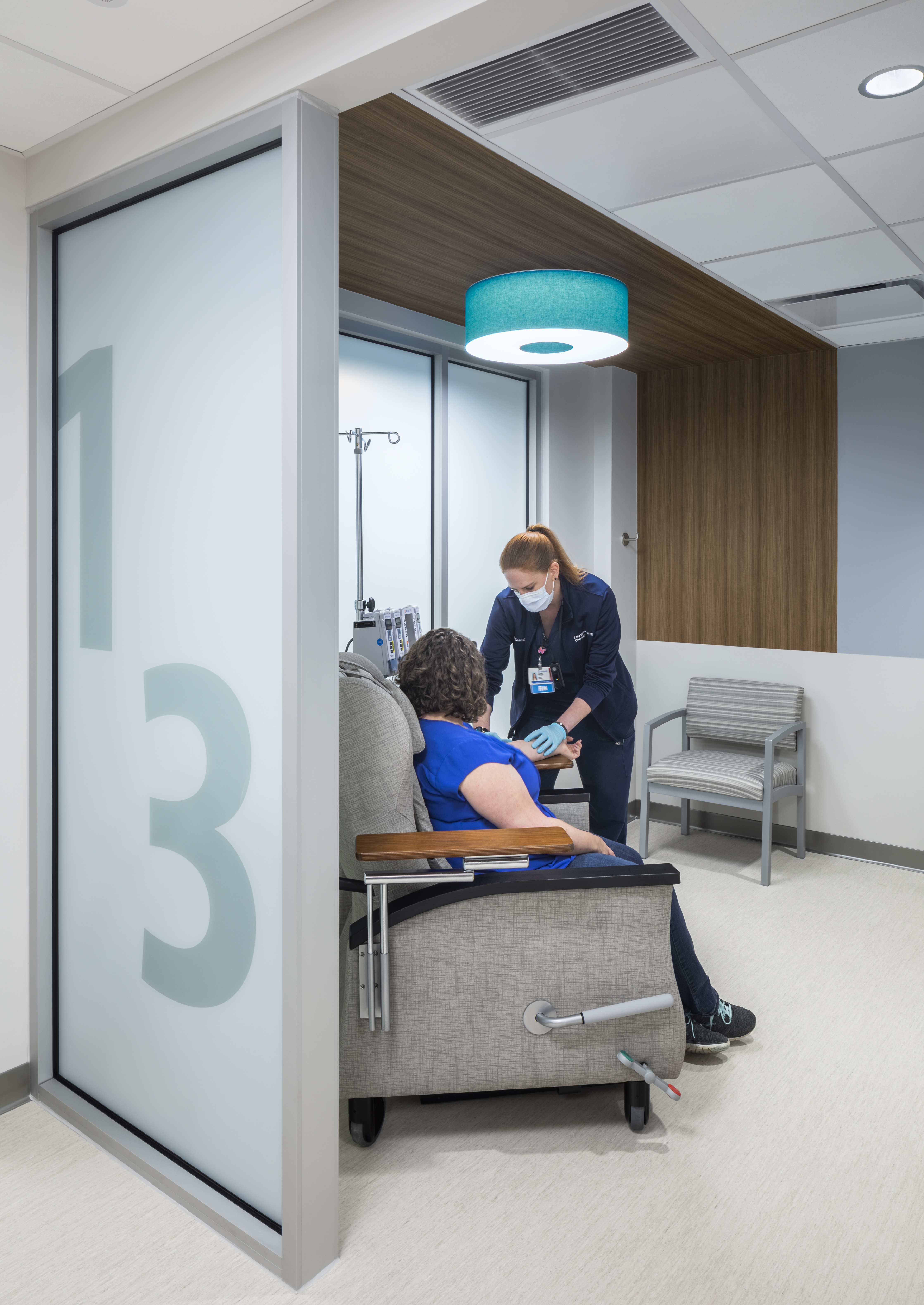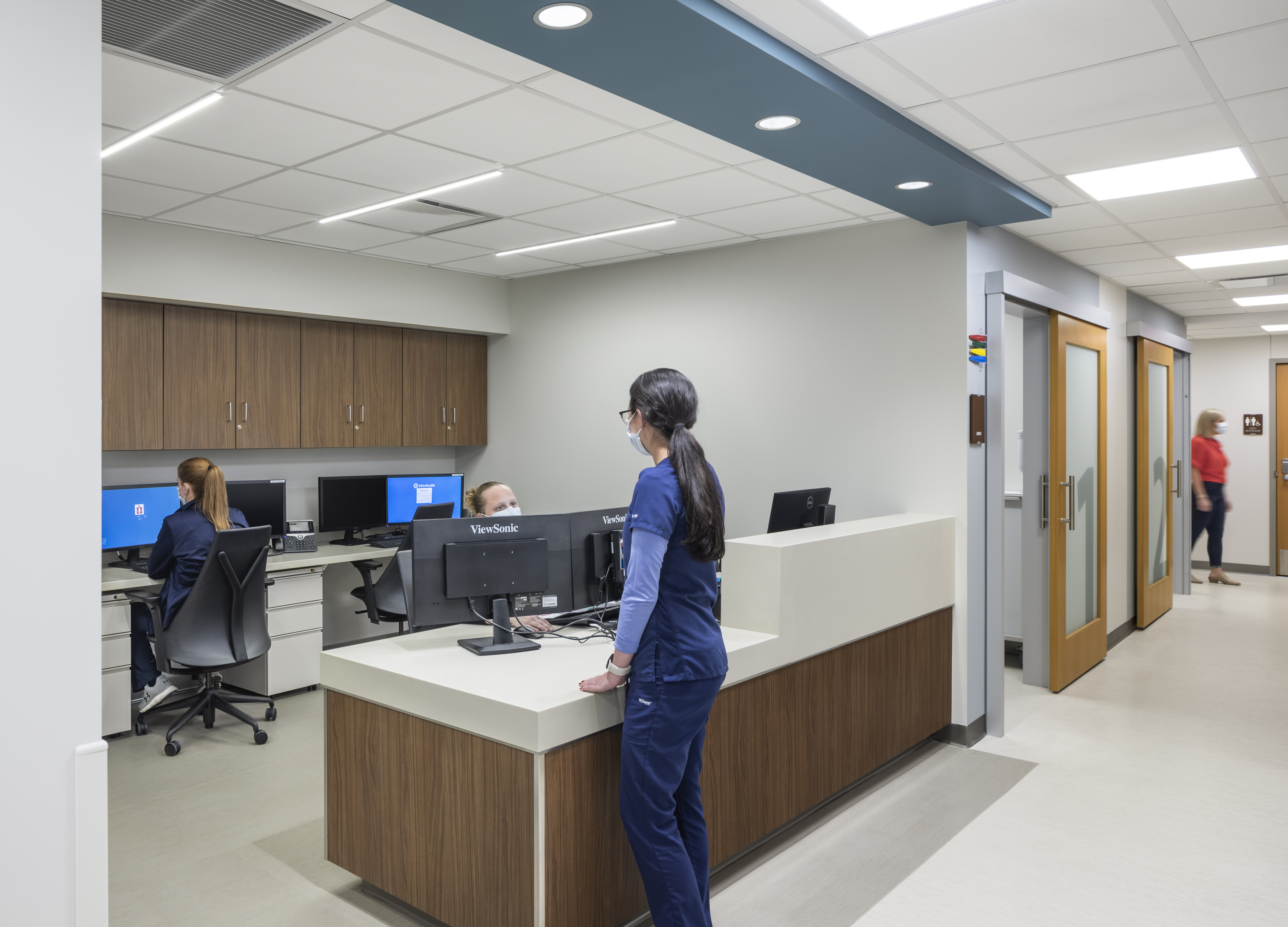To better understand the needs and potential solutions for blood and marrow transplant (BMT) facilities, DesignGroup took a closer look at typical BMT patients and their treatments–both inpatient and ambulatory–and how design might help lower stress, simplify the experience, and improve outcomes. This piece is focused on the ambulatory experience; you can also read our thoughts on inpatient BMT experience design.
By Sarah Eversman, NCIDQ, Associate IIDA
DesignGroup recently worked with the Blood and Marrow Transplant (BMT) Clinic and Infusion departments in the Arthur G.H. Bing, MD, Cancer Center adjacent to OhioHealth Riverside Methodist Hospital in Columbus, Ohio. The overall goal was for both inpatient and ambulatory experiences to feel integrated and cohesive.
We achieved this in part by using similar materials and design elements to create a shared look and feel. We were also asked to design the spaces in ways that help lower anxiety, simplify the experience, and, ideally, improve patient outcomes. Like in our work on the Bing Center’s inpatient department, the design philosophies of calm, connection, and warmth were just as valuable here. The challenge was achieving a light and bright space on a lower level, without windows and natural light.
The patient’s journey begins upon arrival to the building, where they must navigate to the Clinic and Infusion departments in two different ways. The first and perhaps easier travel path is being dropped off at the main entrance. Upon entering, they are immediately welcomed by a smiling face at the reception desk and from there will be instructed to take the nearby stairs or elevators to the lower level and to the subsequent welcome desk. The second travel path consists of parking in the attached garage, entering the building, taking the elevators to the lower level, and continuing to the welcome desk. While the parking option may be confusing for the first-time patient, it will be the preferred method for future visits. Once the patient has arrived, they are escorted by a staff member to the down one of two hallways: to the clinic check-in or to the infusion entrance.

Finding Calm Through Color
The waiting area is open to a large four-story atrium which feels bright and spacious and indicates that the patient journey begins here. Corridors to each department are clean and refined, leading to a wood-wrapped entryway at each entry. While the scale of the atrium and initial travel to the lower level can be a bit overwhelming, the design compresses the patient just enough in the corridors to bring back a soothing and manageable feel.
The deep blue accent paint, signature to this healthcare system, signifies locations for department entry signage and wayfinding elements; while artwork and soothing decorative glass creates a more hospitality-like feel. The same light blue accent that was used in the Inpatient unit can be found highlighting patient zones in both clinic exam rooms and the infusion bays, unifying the facilities as a purposeful whole.
Connection and Wayfinding
The connection component in the outpatient clinic and infusion area is different from the inpatient unit. The duration of the ambulatory stay is much shorter, more catered to the patient and their individual experience, and occurring in a repetitive manner. With guided assistance along the way, patients have the comfort of easier wayfinding from the waiting area to check-in to treatment and back out again.
The clinic patient's path of travel is a more visual experience. The light wood exam room doors have a full frosted glass panel with a large-scale graphic number, with the same light blue accent paint highlighting the entry point. The rich medium blue accent used in the inpatient unit, wraps the clinic staff station from the soffit down to the adjacent wall, once again allowing patients and families to recognize that “this is where we go for help.”
The infusion patient's experience is more solitary. With no cubicle curtains at the bay entrances due to infection control issues, the strategic placement of the frosted glass panels and the patient recliner turns the patient’s view inward to their personal, private space. A wood element wraps the ceiling and wall to envelop the patient and their support person creating a dedicated zone, while a decorative light provides additional glow with personal patient control.

Adding Warmth Through Wood
Bringing warmth into these departments is vital as a calming environment. The public spaces in the building itself, atrium included, incorporate wood elements. The wood in the clinic and infusion areas were intended to ground and comfort the patient, and although these departments are confined to the lower level, they feel bright and open. The Infusion staff stations bring in wood tones with a neutral accent soffit color and are centrally located with an easy visual to all patients. Blue glass tile at the staff station sinks provides a pop of color for everyone in the space and a sense of home. The Infusion bays are encompassed by frosted glass panels at the entrance and in between simulating windows and natural light, while maintaining patient privacy at the same time. Large-scale graphic numbers at each bay tie the Clinic and Infusion departments together with a consistent design language.

Today and Beyond
The BMT clinic and infusion departments have been completed and are living up to our original design expectations. The spaces invoke a sense of calm, warmth, and, above all, a brightness to the space that makes you forget you are in the lower level. Beyond the visual finishes, is the sense of pride that the staff feel working in this unit, not only because of the nature of the department itself, but how the space makes everyone feel, staff and patients alike.

Sarah Eversman, NCIDQ, IIDA
Senior Interior Designer
Sarah brings 17+ years of experience in interior design services for healthcare facilities. Her experience includes working closely with both small and large project teams during ideation and conceptualization through design development and construction documentation. Sarah finds success and value in providing functional, inspiring, and aesthetically pleasing facilities for staff, patients and families and making a positive impact on their well-being.
